This four-image mosaic comprises images taken from a distance of 20.1 km from the centre of Comet 67P/Churyumov-Gerasimenko on 10 December. The image resolution is 1.71 m/pixel and the individual 1024 x 1024 frames measure 1.75 km across. The mosaic is slightly cropped and measures 2.9 x 2.6 km.
As usual, rotation and translation of the comet during the image sequencing make it difficult to create an accurate mosaic. In this particular instance, some distortion terms were introduced to make the mosaic, and careful inspection may reveal some slight mismatches in features at the seams.
In addition, some cleaning has been applied to lower the impact of NAVCAM scattering and make the boundaries between images continuous. So, be cautious in pushing the intensities too far to look at very faint features: in particular, an apparent discontinuity in the main outflow from the neck of the comet is an artefact.
In this orientation, the smaller lobe of the comet is to the right, and the larger lobe to the left.
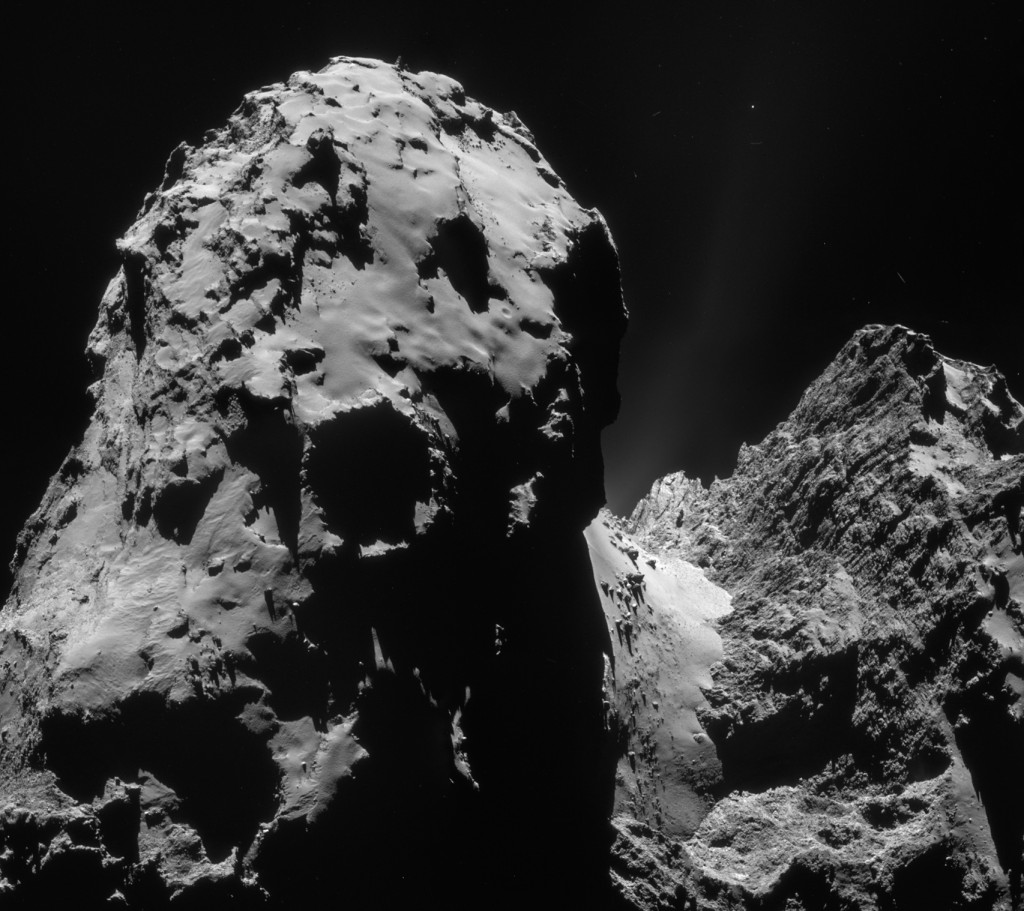
Four-image NAVCAM mosaic comprising images taken on 10 December. Credits: ESA/Rosetta/NAVCAM – CC BY-SA IGO 3.0
The lower right part of the image provides a stunning view on the comet’s ‘neck’ and its constellation of boulders, which were also visible in an image published last week. A hint of activity stemming from the neck is also visible.
The four-frame montage and the individual image frames are provided below.

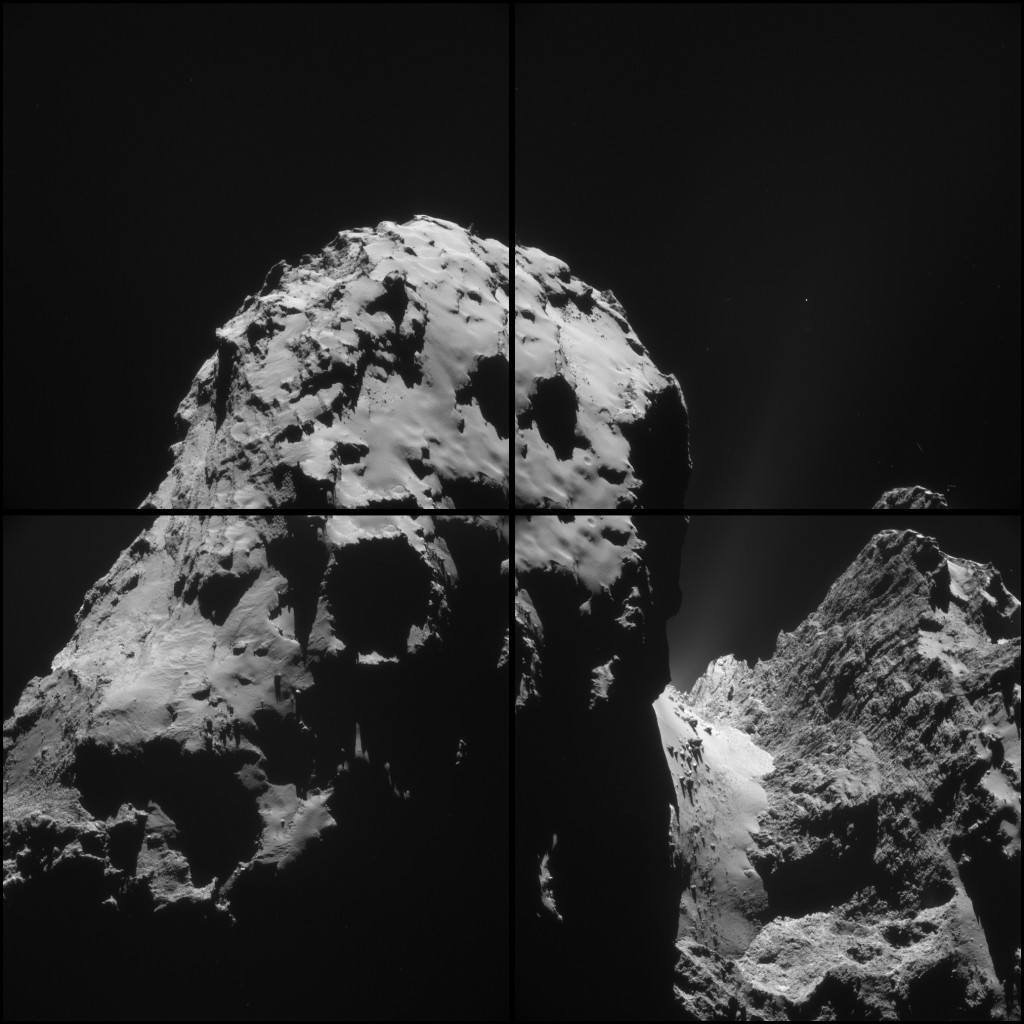
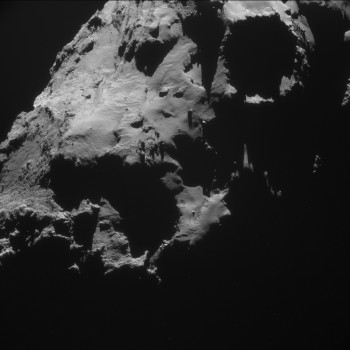
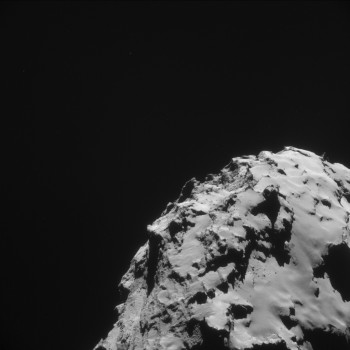
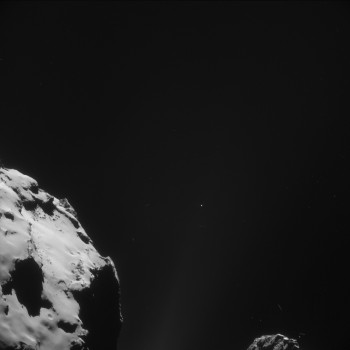
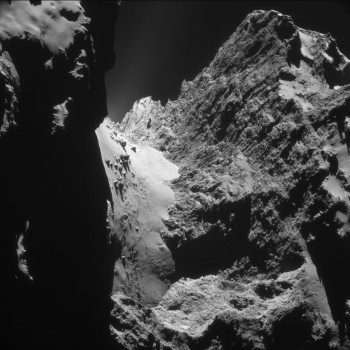








Discussion: 26 comments
Yet another stunning image!
I can’t help but notice what appears to be a possible fresh impact crater, visible in 2 frames. e.g. the corner of ROS_CAM1_20141210C
That crater has been seen in numerous images of the same area before.
Thanks Claudia
That’s a really good perspective on the cliff face, showing it in full relief. I can see some more matches that fit the body, certainly to the right of the cove. I’ve been logging many more here:
https://scute1133site.wordpress.com
Mr. Cooper
In your opinion, what time-frame has this “stretching” taken place?
At the moment we are in a position of ruling out contact binary, and ablation between lobes as reasons for the shape. No matter what timescale, or hard to imagine process, this will prove some sort of stretch has occurred.
Hi Lynn
Marco and I have discussed two ways in which the comet could have stretched: a close approach to Jupiter under the Roche limit and spin-up due to outgassing.
The close approach to Jupiter under the Roche limit is a scenario in which the strong differential gravity can stretch or tear apart a comet. Shoemaker-Levy 9 was shredded into 21 pieces after passing 40,000 km over the cloud tops (110,000 km from jovicentre). So 67P/C-G would have needed to pass perhaps 115,000 to 135,000 km above jovicentre (through the rings) to stretch and not shred. The main phase of close approach would be around 4 hours so it would happen very quickly and catastrophically- that may explain the signs of giant missing slabs over the side of the body. They would have drifted away in the close approach, once detached.
67P probably did pass close to Jupiter in its initial capture into the Jupiter family of comets. It didn’t have to be under the Roche limit but it probably would have been quite a close pass which is circumstantial evidence that it could’ve been really close. Another piece of circumstantial evidence is that it would have had to pass across Jupiter’s bow at a angle to have come from the Kuiper belt and become more circularised The axis of rotation and sense of rotation are consistent with this scenario. The plane of rotation is in line with the comet’s 1959 close approach radiant, which may harbour some vestige of its exit radiant in the paleo close approach.
If you see part 4 of the series in my link above, my colleague who runs the Roche pass simulations has just left a comment with a link to videos and pictures of simulated rocks getting distorted in various passes near the Earth. One interesting thing is that the initially spherical body stretches, dips down, and then when it has passed bottom dead centre, the lobe kicks backwards in the same manner that 67P’s head is tilted upwards at the ‘back’ where the cliff is. The result is two lobes that form a dumbbell with crooked ends. His simulations resemble a multitude of existing dumbbell-shaped asteroids including dog-bone shapes that are identical to Kleopatra.
The other way a stretch might occur is via spin-up to a fast rotation, enough to overcome the inherent gravitational force of the comet. This might happen via asymmetrical outgassing acting as a torque which spins up the comet. The recent paper on 67P/C-G’s rotation suggests that the recent spin-up from 12.7 hours to 12.4 hours is due to asymmetrical outgassing. It’s difficult to say how long it would take to stretch the comet via this process but it would take quite a few orbits I would think. But even if it’s hundreds of years to spin up then spin down, that’s a blink of an eye over the comet’s lifetime of course.
Thought you might be interested in this image taken on the 14th of August.
https://www.flickr.com/photos/124013840@N06/15848858567/in/photostream/
The red arrows mark features that continue from body lobe to head lobe, with the face of the fracture plane clearly visible on the body lobe.
This image also shows quite a bit of the back of the head lobe which is usually hidden in darkness. There is a nice view of Landing Site B and it’s crater rim. The cliff on the back of the head actually has a number of ledges.
I added in Philae’s flight path as well. Every different view gives a different idea on what happened after the touch/graze on the crater rim. In this view it would appear Philae barely changed direction, but had her speed greatly reduced. She may have been lifted a bit higher, but basically just tumbled head over heels over the edge of the crater rim and then dropped very slowly down to the ledge below, (not visible here), outlined by the CONSERT search area. Of all the trajectories I have tried to image this would seem the most plausible, mainly because the angle of the image removes most of the vertical dimension, making a 2D visualisation more realistic..
Thanks Robin
Your arrows are neater than my dots! Please feel free to add more matches. I’ve seen many more since posting mine. Some match very finely but my annotation skills aren’t fine enough to pinpoint them.
You may be interested in the underside image of the area you arrowed. It shows the flat, edge rim in the head which looks almost as if it’s been machined to fit to the body where your arrows point. It looks like the lid of a sarcophagus, complete with rebate that faithfully turns the 90 degree corner above your bottom arrow.
The image is here in part 3 of the series (photo 1):
https://scute1133site.wordpress.com/2014/12/15/67pchuryumov-gerasimenko-a-single-body-that-was-stretched-part-3/
It also shows that the line where head and body sheared, follows the same ups and downs in both lobes.
If anyone else can find matches I can follow up on them in detail. Best to check the photos in the series of posts first (navigable from link above) in case I’ve found them already. Tip- you need to look at each area from several angles, preferably under different lighting conditions! All the published images are at:
https://www.esa.int/spaceinimages/Images
One way or the other… I am waiting for the first one on ski’s to come down…
Wonderful picture ! Did you spot Philae on one of the recent pictures? Or it’s hidden into shadow and can’t be seen?
Hi–
One of the most aesthetically pleasing images taken so far by Rosetta! You get a real feel for the depth and bulk of the nucleus.
On a more scientific level, however, we would love to see an updated version of the 3D model of the nucleus.
–Richard
Thanks Claudia. The neck plain has changed its appearance over the last 3 months. There are lots more smaller cryorocks emerging from the dust. On the head side of the central cryoboulder line the smooth even appearance of the dust has taken on a mottled, spotty appearance. Lots of darker grey roundish shapes that are clearly not cryorocks or shadows, just areas where the surface layer has been disturbed. Those look similar to the “boiling sand” analogy mentioned some time ago. The sublimating gases from the subsurface bubble up from beneath the porous surface layer, through the layer turning and churning the surface. If theoretical computer models are correct this would create collimated jets of gas and dust. These don’t appear to be of a size responsible for the large streamers we have seen, but contribute to the overall outgassing of vapour from the comet, the latest estimates being around 30 litres of Water a second, that is around 100,000 litres per comet day. This means the comet is probably losing upwards of 200,000 Kg of material a day into the coma. What is that figure going to be in eight months time at closest approach to the Sun?
“The neck plain has changed its appearance over the last 3 months. There are lots more smaller cryorocks emerging from the dust”
Hi Robin,
I thought so initially too, but after a careful examination of this image:
https://www.esa.int/var/esa/storage/images/esa_multimedia/images/2014/09/comet_on_24_september_navcam/14840362-1-eng-GB/Comet_on_24_September_NavCam.jpg
I struggled to find something I was confident was new. I suspect this particular perspective (above) crowds the rocks on the neck and makes it loook like there are more of them. And the lower angle of the illumination seems to create the more mottled appearance, as well as making smaller boulders more visible.
I wonder what is the surface temperature on sunny side? And more important, is there really water(H20) found in the coma?
Wrom what I’ve red on these pages no water was found on the surface, something similar to water(H with aditional neutron) in the atmosphere.
MIRO detected molecular water a while back. It has also been detected directly as H2O in the infrared both from the Hawaii telescopes and the Kuiper airborne obse vatory, back in the 80’s on other comets.
No water is expected on the surface given the pressure.
Whaow!
Those pictures are wonderfull!
Does anybody noticed the three small craterlike holes in the very middle of the last image situated at the limit between dust and” rock”. Maybe artefacts .
Dust jet vent activity on 24 Sept 14, 2 Oct 14, 9 Dec 14 and 10 Dec 14.
https://univ.smugmug.com/Rosetta-Philae-Mission/Rosetta-Comparative-Series/i-XTTqqmM/0/L/compar_24sept_2oct_9dec_10dec-14_vent_activity-L.png
–Bill
Another large white off-comet blob in image C (590, 601), but is it real. It’s at least 2 pixels by 2 pixels (3.4m by 3.4 m), but could be consistent with a 5 metre boulder.
I wonder if the large white off-comet blob in image C (590, 601) is in orbit around the neck.
A similar sized object can be seen on the bottom edge here:
https://blogs.esa.int/rosetta/files/2014/11/ROS_CAM1_20141120C.jpg
And here:
https://blogs.esa.int/rosetta/files/2014/11/ROS_CAM1_20141117C.jpg
Hi Bruce. Its suspicious that it is in a similar place from a similar viewpoint. The second image you mention, the blob appears to be splitting a streamer and is closer to the comet surface so the pressure from the streamer could have pushed it further out. From that image I reckoned it was nearer to 10 metres in size, but in a constant steam of gas and dust it may well have been eroded to half its original size in the last couple of weeks.
In this image the blob still appears to be at the end of a streamer, but does not seem to be interacting with it. We both commented at the time that it could be a boulder sized piece of debris.
If these larger streamers are coming from subsurface pressurised chambers, when they do blow their tops it would seem possible that some lumps of the still ice laden sub surface might be carried up in the streamer. The fragile nature of near surface material, with all the volatiles sublimated out of it, it becomes a skeleton made of dust, the slightest puff of gas will reduce it to powder.
Probably planet ( or star) otherwise more likely to have a smear due to motion during exposure.
And the myriad blobs that can be seen above the neck in this image
https://www.esa.int/var/esa/storage/images/esa_multimedia/images/2014/09/comet_on_24_september_navcam/14840362-1-eng-GB/Comet_on_24_September_NavCam.jpg
There appears to be much off comet debris following along.
The last image is like looking up at Mount Everest
sci question: He….
has He been seen in the outgassing?
How much, if any?
Thinking of that anomaly that geoligical petroleum deposits are rich in He,
and then there are these old stories about fire and tar raining from the sky…
any buckyballs…?
how much H vs C in the surface dust?
maybe comets brought us petroleum….
There is lots of it deep in the mantle.
And with respect to where the oceans come from, there has been recent work about the high water content of the upper mantle (of course not ‘liquid’ but bound into the tixotropic mantle material, whatever it is). That water ‘sweating out’ may well have made the oceans over time.
the coolest thing about it all is that it is absolutely unexpected, at least to me.
I knew some bad scientists will be in trouble when I saw that ‘rubber ducky’ shape…. too funny a curve ball by nature!
oh, just occurred to me:
anything about the distribution of C isotopes, by chance?
I know, instrumentation might not have been geared towards that, when Rosetta was sent out ten years ago, science had to work with current hypotheses, current at that time….
For those looking for water to make the earths oceans,
Try Proffesor Wendy Panero Ohia state University – sthints the ancient earth made its own waterBy: Wendy Panero , The Ohio State University
In a finding that meshes well with recent discoveries from the Rosetta mission, Ohio State University researchers have discovered a geochemical pathway by which Earth makes it own water through plate tectonics. This finding extends the planet’s water cycle from millions to billions of years—and suggests that enough water is buried in the deep earth right now to fill the Pacific Ocean.
Do we need asteroids?